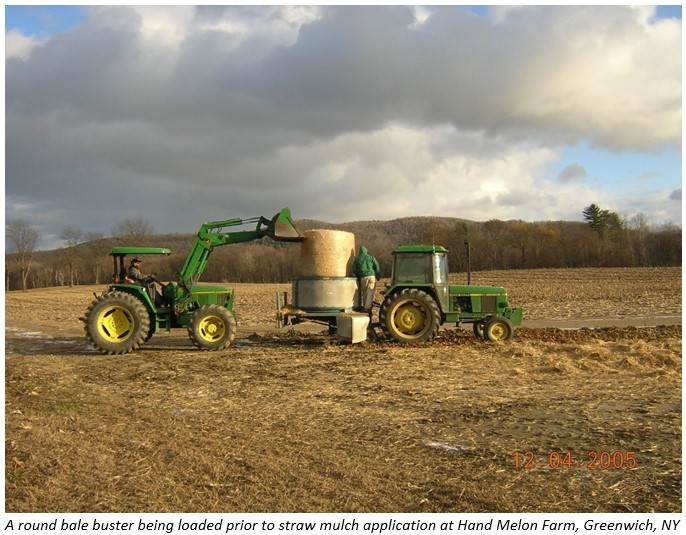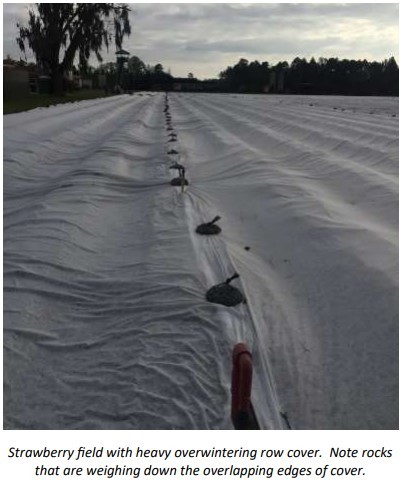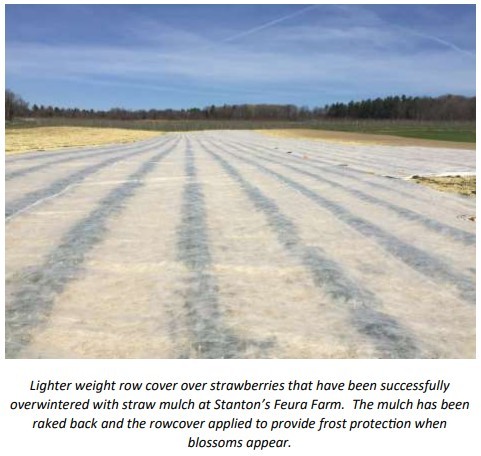Overwintering Strawberries - Timing of Fall Mulch Application and Spring Removal
Laura McDermott, Team Leader, Small Fruit and Vegetable Specialist
Eastern New York Commercial Horticulture
Successful overwintering of strawberries is a tricky business and not giving it enough consideration can result in poor yield the following year.
Strawberries are perennial, and like most perennial plants they begin to go dormant as day length diminishes and cold temperatures set in. During this period of cold acclimation the plants are still very active - in fact this is when the fruit buds are being developed for the following seasons' crop. You will see changes in the appearance of the berry plants as cold acclimation advances. Leaf development stops, the leaf petioles become horizontal, and the plant appears to flatten out, and older leaves turn red.
The challenge with cold acclimation is that plants don't become ‘hardy' until cold acclimation is completed. Hardiness is effectively reached when freezing temperatures exist for 2-3 days - so not just night minimums but a good hard cold spell. Ideally that cold would continue for the duration of the winter. Hardiness allows plants to resist low temperature damage. Strawberry plant hardiness - or ability to resist cold damage - continues to increase as the days get shorter.
Photosynthesis is also required for cold acclimation to occur, so plants which are mulched before these environmental conditions have been met will not be fully winter-hardy. Strawberry plants are not as tolerant of cold temperatures as other perennial fruit crops even when fully acclimated. Variation in production systems like raised, plastic mulched beds further complicates a seemingly easy task.
Cold injury appears in the spring as either fully dead plants or more likely, very weak plants. The crown tissue browns. Temperatures in the single digits can kill crown tissue, but even temps in the mid-teens can cause fewer flowers and fruit, if those temperatures occur while tissue is in a non-dormant phase.
This is where mulch comes in. Mulch mimics snow - which is a great insulator against cold. Mulch prevents crown desiccation from wind, moderates soil temperatures and prevents freeze-thaw cycles that can damage plant roots and lift crowns out of the soil. Research suggests that using soil temperature as your timing guide is the best way to plan for mulch application. When soil temperature drops to 40°F or below, after three hard freezes, apply mulch. This usually happens between mid-November and mid-December. Mulch should be applied at 2.5 to 3.5 tons per acre and should be an evenly distributed depth of 2 to 3" thick after it settles.

What type of straw? Straws from wheat, oats, rice or Sudan grass can be used - just be sure the straw is free from weed seeds and don't use straw that was treated with glyphosate at harvest as strawberry plant injury has been reported when the straw was treated close to the date it was baled. Straws coarser than Sudan grass and hay are not recommended as they tend to mat down and trap water during the winter which can damage strawberry crowns. Strawberry growers can produce their own straw, often cutting the straw before the grain seed is viable. If grain seedlings become a weed problem, apply sethoxydim in the spring.
Raised beds complicate things. Raised beds can be at least 5°F colder than flat beds, but mulching overcomes most of this negative effect. An additional challenge is that the berry cultivars grown in raised beds are sometimes not as winter hardy as traditional June bearing varieties.
There are two methods that have proven successful for growers using raised beds covered black plastic mulch. Floating row covers, like the heavyweight Typar 518 (1.25 oz/yd2 or 42 g/m2) can be used instead of straw. Row covers should be applied on a calm day using the same soil temperature guides as with straw mulch. The edges should be anchored with rocks or sand bags and then covered with soil to prevent the fabric from becoming a sail during the winter. Many growers have reported that the combination of black plastic lined beds, with a floating row cover, provides adequate winter protection, even in colder regions of the northeastern USA.

The second method requires straw mulch applied at a heavier rate than in a flat field situation. It's important to provide enough straw that if it slides off the top of the bed into the row alleys that there is still some straw left to protect the crowns. The rate will vary with the height of the beds, but usually it requires a minimum of 4 tons per acre of straw in a raised bed system.
Many growers are experimenting with combining straw and row covers, or using double layers of row covers. Whatever the method you choose - make sure that you are timing the application properly by using soil temperature as your guide.
Proper timing of mulch removal is critical. This past spring, the weather was cold and cloudy for most of March and into April. The concern over bloom protection in frost events (admittedly the worst job in farming) led growers to keep mulch on berry plants far too long resulting in many poor looking berry plantings. Keep in mind that unlike deciduous perennials, strawberries still have leaves during their dormancy. That results in a very low level of respiration that occurs even during the winter - but as air and soil temperatures warm, and day length increases - the plants move out of dormancy and start growing. They have received sufficient chilling and they are ready to go!
For overall success, growers should remove mulch when soil temperatures reach 40 degrees, or they should plan to do it by early April in our region. Leaving mulch on the plant well into April results in crown rot and starved plants that don't bounce back in time for harvest. This situation is one reason why growers have moved to using row covers for mulching. Row covers allow some light and the plants can start growing a bit earlier than they might with a heavy straw cover. Straw mulch can be raked off by hand or modified hay rakes have been specifically designed for the purpose.

What about fertilizing plants after mulch is removed? If plants look very stressed, or have obvious winter injury or lots of deer browse, a light fertilizer application might be appropriate. Research results indicate that Nitrogen rates above 30 lbs/acre applied in the spring will push plant growth at the expense of fruit production. Calcium nitrate is absorbed well in cold soil situations, and potassium will be pulled up through the plant as it transpires. Nitrogen rates ranging from 5-15 lbs of actual N per acre have been seen as appropriate at this early stage.
Other factors that impact overwintering success include deer browse and diseased plants. Autumn deer browse is a serious problem in our region. Deer fencing is the only consistently effective way to insure that deer don't get into your strawberries. Applying mulch earlier than required is not a good way to minimize deer browse.
Strawberry plants with serious leaf spot infections have been shown to have significantly poorer bud development in the fall and thus lower yield in the spring. There is some indication that these plants are more susceptible to winter injury compounding the loss the following year.

Upcoming Events
Wine Sensory Evaluation Workshop
April 26, 2024 : Wine Sensory Evaluation Workshop
Staatsburg, NY
In collaboration with Jeremy Schuster, Viticulture Specialist at the ENYCHP, Dr. Anna Katharine Mansfield and Chris Gerling, Enology Extension Specialists with the Cornell Craft Beverage Institute, will be presenting a wine production-focused, interactive workshop on sensory evaluation.
What is my vine trying to tell me?
May 15, 2024 : What is my vine trying to tell me?
Plattsburgh, NY
Are your grapevines showing signs of discoloration or stunted growth? Don't ignore these warning signs! Join us on May 15th at the Cliton County CCE office to learn about the essential nutrients that grapevines require to thrive, identify the symptoms of nutrient deficiencies, and how to fix them. Don't miss out on this opportunity to improve your grapevine cultivation skills! Attendance is free, but registration is required.
How man's best friend can help find Spotted Lanternfly
May 21, 2024
Millbrook, NY
Come and join us at the Dutchess County CCE office on May 21st for a special demonstration by Jennifer Fimbel, the Agriculture and Horticulture Program Leader with Dutchess County CCE. You will get to see her SLF K9 Cole in action as they demonstrate how man's best friend can be used to detect the Spotted Lanternfly. Attendance is free, but registration is required












































